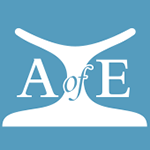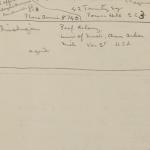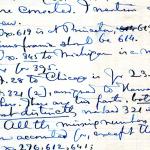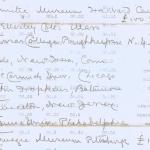Ann Arbor, MI, Kelsey Museum of Archaeology, University of Michigan
The history of the Kelsey Museum is given on its webpage [ https://lsa.umich.edu/kelsey/about-us/history.html accessed 8 May 2017]: "The Kelsey Museum is the brainchild of Francis W. Kelsey, Professor of Latin at the University of Michigan from 1889 to 1927. Kelsey pursued an active program of collecting antiquities for use in teaching, and launched the first university-sponsored archaeological excavations in the Mediterranean and Near Eastern regions in 1924. Most of the artifacts in the Kelsey Museum come from excavations carried out in Egypt and Iraq in the 1920s and 1930s.
In 1928, shortly after Kelsey’s death, the Museum of Classical Archaeology was installed in Newberry Hall on State Street. It was renamed in honor of Professor Kelsey in 1953, and enlarged with the construction of the William Upjohn Exhibit Wing in 2009"
There are 54 objects listed on the online database as coming from Flinders Petrie in the early 1920s. The original distribution records in the Petrie Museum in London relating to these objects can be found under the entry for 'Michigan' which can be accessed in the menu to the right.
Professor Francis Kelsey had corresponded with Flinders Petrie since at least 1918 and subsequently visited him at Lahun in late 1920. Kelsey requested some duplicates for the study collection of the Classics Department at Michigan (unsigned, unmailed draft of letter from Kelsey to Petrie, 26 March 1920, Kelsey Museum). According Diana Ng (2007) the crate containing the artefacts left Southampton at the end of September 1921 and it arrived at the University of Michigan in time for a small exhibition in the University Library, which ran from Christmas 1921 through January 1922, “in honor of the Archaeological Institute of America, which met [at the University of Michigan] in conjunction with the American Philological Association”.
The five libation cups in the collection are examples of objects that were very occassionally given to all subscribers to the Egypt Exploration Fund. All five pieces came via a Wallace N. Stearns, of Fargo, North Dakota, July 18, 1913. It is listed as a gift from the Committee of the Egypt Exploration Fund and is accompanied by a typewritten note:
"Libation Cup from Abydos. The Committee of the Egypt Exploration Fund presents to members of the Society assisting in clearing the Royal Tombs and vast temple area at Abydos libation cups dedicated ex-votos by the pious during the religious ceremonial rite in the open desert
necropolis between the XIXth and XXVIth dynasties to memories of the ancient kings and to the great god Osiris. The Book of the Dead, chapter 183."
Related archive documents
Ng, Diana, 2007. The Petrie gift in the Kelsey Museum of Archaeology. Bulletin of the University of Michigan Museums of Art and Archaeology 17: 65-84. Permalink: http://hdl.handle.net/2027/spo.0054307.0017.104






